As the site is updated, each listing includes the shipping cost. Some listings which I have not updated still give you calculated shipping costs based on weight and size of package. (In the sections I have updated) If you select several different listings, we will consolidate your order and charge you the actual cost of the entire package. The shipping over charge will be refunded to you, when your order is shipped.
MITER SHELLS
Mitridae, known as mitre shells, are a taxonomic family of sea snails, widely distributed marine gastropod molluscs in the clade Mitroidea.
Both the Latin name and the common name are taken from the item of ecclesiastical headgear, the mitre or miter, used in reference to the shape of the shells.
The dentition of radula (The radula is an anatomical structure used by mollusks for feeding, sometimes compared to a tongue. It is a minutely toothed, chitinous ribbon, which is typically used for scraping or cutting food before the food enters the esophagus. The radula is unique to the mollusks, and is found in every class of mollusk except the bivalves, which instead use cilia, waving filaments that bring minute organisms to the mouth.) in the Mitroidea is rachiglossate, with well-developed central and lateral teeth, both comb-like. Members of this family are predators(Ponder, Winston Frank; Lindberg, David R.; Ponder, Juliet Mary (2019). Biology and Evolution of the Mollusca. CRC Press. p. 1934. ISBN 978-1-351-11564-3.).
These sea snails are found in most warm and temperate seas.
Miters are common especially in the tropical Indo-pacific region. Most miters live in the intertidal zones, preferring sand, coral areas or stoney seafloors. Many are predatory mollusks and a few are scavengers.
Scientific classification
Domain: Eukaryota
Kingdom: Animalia
Phylum: Mollusca
Class: Gastropoda
Subclass: Caenogastropoda
Order: Neogastropoda
Super family: Mitroidea
Family: Mitridae
Swainson, 1831
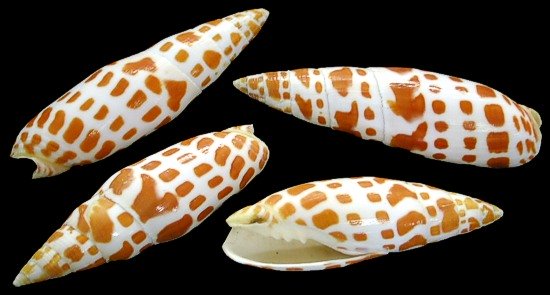
MITRA MITRA SHELL
Mitra mitra, common name the episcopal miter. Thus the shell got its name from resembling a bishops miter. This species is a large predatory sea snail, a marine gastropod mollusk in the family Mitridae, the miters( Rosenberg, G. (2010). Mitra (Mitra) mitra (Linnaeus, 1758)).
Widespread in the Indo-Pacific, from East Africa, including Madagascar and the Red Sea, to eastern Polynesia. North to southern Japan, Wake Island and Hawaii, and south to Australia (Poutiers, J. M. (1998). Gastropods in: FAO Species Identification Guide for Fishery Purposes: The living marine resources of the Western Central Pacific Volume 1).
This species lives in intertidal and sublittoral zones, to a depth of around 263 feet. (Poutiers, J. M. (1998). Gastropods in: FAO Species Identification Guide for Fishery Purposes: The living marine resources of the Western Central Pacific Volume 1).
Mitra mitra are known to be carnivorous, an active predator that feeds on smaller gastropods and bivalves.
The maximum shell length for this species is around 7 inches, usually to 5 1/2 inches. Like in all Mitridae, the shell is elongate, somewhat fusiform, with a high spire. The aperture is elongate and narrow, and the outer lip is smooth and not lirate (grooved). Unlike other species of the genus Mitra, the spire is not strongly shouldered. The surface of the shell is smooth, with a few weak, spiral grooves towards the anterior end. The color is white, with spiral rows of large irregular orange or red spots (Poutiers, J. M. (1998). Gastropods in: FAO Species Identification Guide for Fishery Purposes: The living marine resources of the Western Central Pacific Volume 1).
Scientific classification
Kingdom: Animalia
Phylum: Mollusca
Class: Gastropoda
Super family: Muricoidea
Family: Mitridae
Genus: Mitra
Subgenus: Mitra
Species: M. mitra
Binomial name: Mitra mitra(Linnaeus, 1758)
J0-17
One Mitra Mitra shell specimen measuring 1 to 2 inches....... .65
J1-17
One Mitra Mitra shell specimen measuring 2 to 3 inches........70
J2-3-17
A Mitra Mitra shell specimen measuring between 3 and 4 inches........$1.29
J4-5-17
One Mitra Mitra specimen shell 4 to 5 inches......OUT OF STOCK
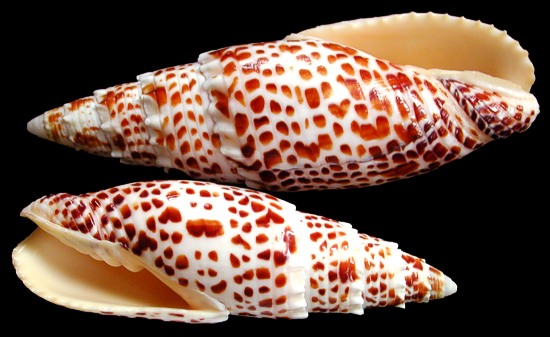
MITRA PAPALIScommon name Papal/Pontifical Mitre
Mitra papalis are species of sea snail, a marine gastropod mollusk in the family Mitridae, the miters.
Mitra Papalis are present in India and in the western Indo-Pacific (Mitra papalis. Gastropods.com.).
These sea snails live on coral reefs and under rocks, from the intertidal zone to a depth of about 99 feet (LI Bao Quan, LI Xin Zheng - Report on genus Mitra with seven new record species from the Chinese seas).
Shells of Mitra papalis can reach a length of about 2 1/2 to 6 1/2 inches. The form of these large shells is similar to a Papal mitre (hence the common name). They are elongate to ovate, fusiform and smooth but without axial streaks on the surface. Sutural coronations are present. The aperture is moderately wide, smooth within. The shell surface is white, with small white nodules under sutures and with several rows of irregular bright red-orange or purplish blotches.(Mitra papalis". Gastropods.com.)
Scientific classification
Kingdom: Animalia
Phylum: Mollusca
Class: Gastropoda
Super family: Muricoidea
Family: Mitridae
Genus: Mitra
Species: M. papalis
Binomial name: Mitra papalis
(Linnaeus, 1758)
V1-3
One specimen of Mitra Papalis shell, measuring between 2 to 3 inches. ......$1.49
V2-3
A Mitra Papalis shell specimen measuring between 3 and 5 inches.......$2.10
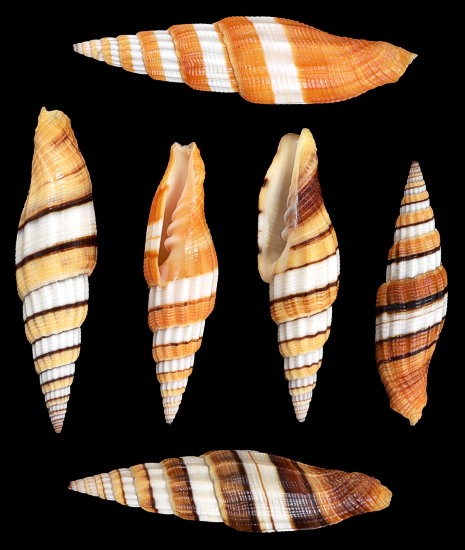
MITRA TAENIATUM
Mitra Taeniatum shells are part of the Miter shell family.
The Mitre family of shells is renowned for their vibrant colors and decorative features. These shells may exhibit a smooth surface or be adorned with spiral ribs or vertical folds..
Miter shells are predominantly located in the Indo-Pacific region, extending from the Indian Ocean to the southern coasts of Japan. They typically reside in the intertidal zone and are commonly found amidst coral, buried in sand, or beneath stones.
Miter shells, also known as Mitra Taeniatum, exhibit predatory behavior and occasionally engage in scavenging.
T1-17
One Mitra Taeniatum shell measuring 1 to 2 inches. ...... $2.49
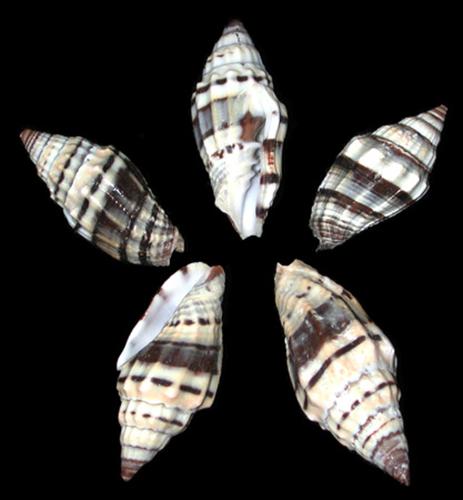
GIANT MITRA SHELLS
Giant Mitre, also known as Plicated or Plaited Mitre shells, are part of the Miter shell family.
IO-18
A Giant Mitra shell measuring approximately 1 1/2 inches....... .26
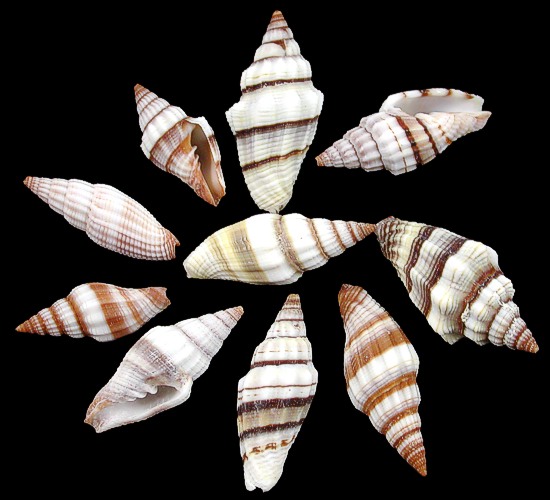
MITRA SHELLS
01-10
A Mitra shell measuring between 3/4 and 1 1/4 inches....... .04
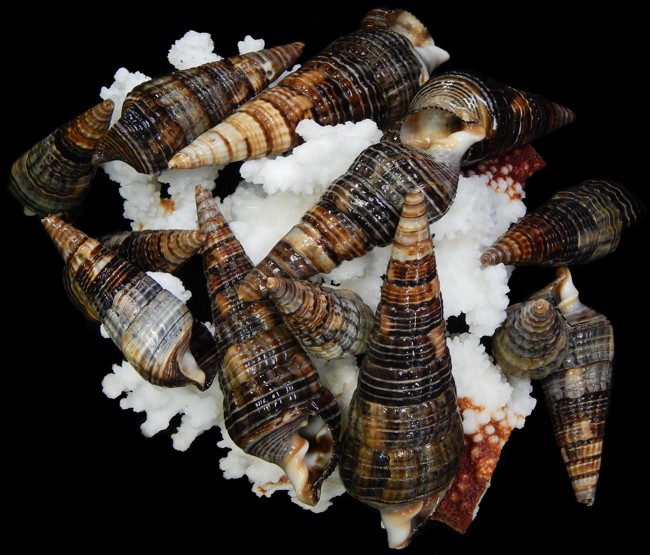
BROWN & WHIE MITRA SHELL
YY2-9
One Black Mitra Shell, size ranging from 2 3/8 to 4 inches. ... .59